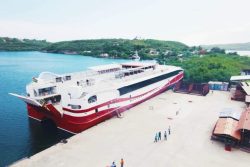The Rufaro Centre? I admit that until the email came to my inbox in late December, I had no idea what the Rufaro Centre was. I had never heard of it. Reading the document circulated on behalf of its “Reimagining Borders: Talking Art…” event scheduled for January 27 to February 3, 2023, I felt encouraged that perhaps an autonomous meeting space for artists was coming into existence. But autonomous does not mean without an agenda and I am weary. Nonetheless, I was equally encouraged by the use of a system of democracy to include a wide cross-section of artists. They had in essence prepared a Call-for-Artists. This system is relatively unused in Guyana.
Instead, in Guyana exhibition organisers routinely call on those whom they know. Alas, this process means calls can be made based on who is in the organiser’s good graces and exclude those who are not. I recall a situation in the early 2000s. The Guyana Women Artists’ Association (GWAA) was seeking funding to produce a calendar. Being proactive, I went into the Georgetown office of a prominent Caribbean company already in the habit of producing art
calendars. I had with me, the GWAA’s updated photo album. I met with a junior manager. Turning the pages, she was astonished and asked whether these artists were in Guyana. I said yes. She was in disbelief. She explained that a Caribbean curator was, as we spoke, in Guyana looking for women artists to be represented in the company’s annual calendar. She had been referred to only one person. Indeed, only one woman artist in all of Guyana! This junior manager immediately called the visiting curator and a meeting was arranged with the dozen artists of GWAA who had already expressed interest in their work being featured in a GWAA calendar. Each presented their work and the process ensued. The visiting curator was impressed with a number of submissions. Work of a GWAA member was selected to represent Guyana and two of her paintings were acquired for the company’s collection. So, you see the dangers of handpicking?
The call-for-artists format is one I advocated for when participating in the planning of Guyana’s visual art presentation at Carifesta X Suriname and Carifesta XI Haiti in 2013 and 2015 respectively. I served on both visual art committees and wanted selections of the contingents to be made on the basis of who was doing work, expressed interest, and for the selections to be done in accordance with a defined and articulated set of criteria.
The email about the “Reimagining Borders: Talking Art…” event came to me from an artist friend with the suggestion I give a presentation. Because I knew I could not commit to such, I proposed a roundtable discussion on art in Guyana. Fun topic. Not really. Contentious is more the case. Why are our best artists not living in Guyana and if they are, not even showing work in Guyana? I am very aware the artists I’ll put in this category will be small compared to that of those who look at art in Guyana. But I like to be as intellectually engaged as I am visually stimulated. So achieving appreciably on both will earn an artist that distinction. Otherwise, I’ll give credit where credit is due and where it is not, I will not. But that is my prerogative. Not everything out there presented as art is art. Some of it operates more as craft than as art. But that is a separate ticklish discussion.
Chatting with one of the event’s organisers and perhaps its principal architect Clairmont Chung in early January, I’m encouraged by their aim to temporarily erase the multiple borders that exist and are hindrances to the development of a robust art situation in Guyana. Firstly, I see an effort to encourage open and collective dialogue between artists in the diaspora and artists resident here. Secondly, I see an effort to have art discussed in atypical and accessible spaces in Guyana. And thirdly, I see an effort (albeit temporarily) to decentralise art. But I am skeptical that the organisers are not the local artists themselves. I am also skeptical that it will be a meeting of friends, having the same sort of grumbling conversations, and that new voices may not be audible or meaningful plans may not be devised for the benefit of the artists themselves. I have other reasons to be skeptical but I will keep those to myself.
I have aspirations for the one-week meeting. But that could be me being the optimist and not the realist. I’m hoping that more than displaying art (and possibly craft) in the pop-up exhibition space, artists will have time to engage each other on what they are each doing and the ideas informing their work and that this can be a space for fertilisation. I am definitely not interested in cross-fertilisation or the politics of art in Guyana…and I do mean politics whether from political
parties or fringe groups. I am hoping that out of the meeting, the individual artists will feel emboldened to embrace a much wider visual discourse than we have thus far as a collective and that they will find ways of working with and on behalf of each other. I am hoping that instead of being responsive to the market (political or commercial) artists will be equally, if not more, responsive to their mandate as artists to simply make art and to push its parameters.
By the time you read these words, the “Reimagining Borders” event should have concluded. My wish is twofold; I hope it succeeds in energising a community in need of collective re-energising and that it is able to achieve its goal of erasing borders, even if only temporarily, to initiate dialogue between artists and between artists and communities that might otherwise traverse their separate spaces oblivious about the other.
Akima McPherson is a multimedia artist, art historian, and educator







